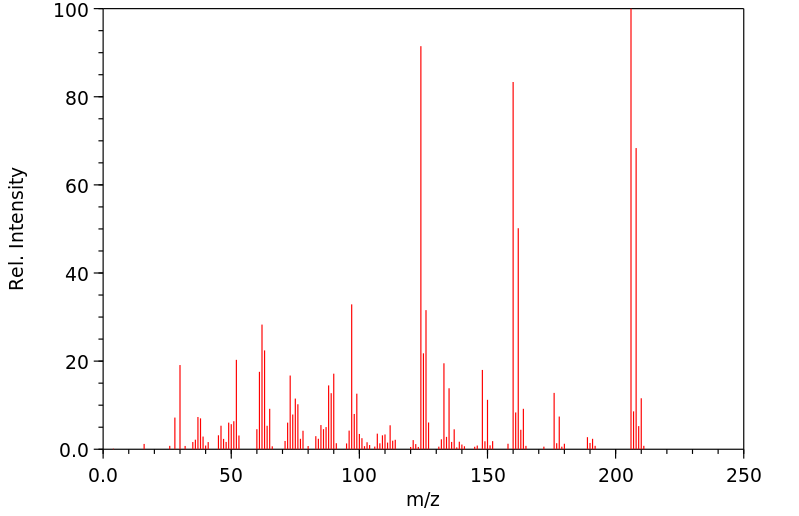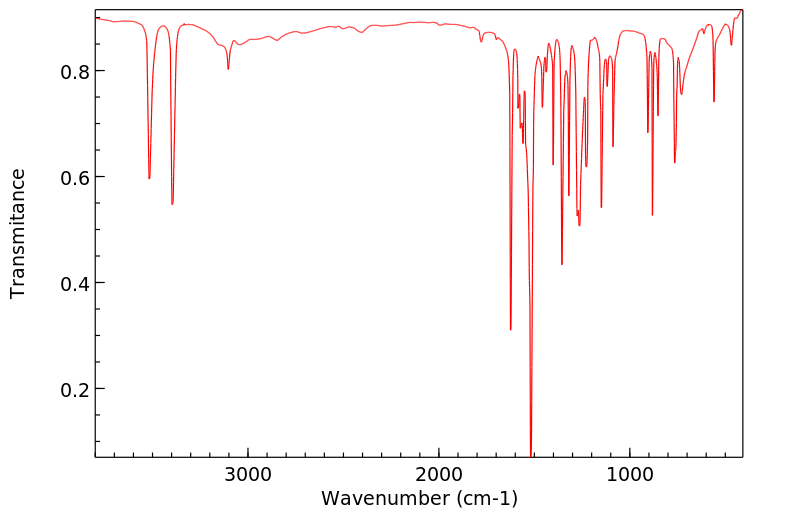2,4-二氯-6-硝基苯胺 | 2683-43-4
中文名称
2,4-二氯-6-硝基苯胺
中文别名
——
英文名称
2,4-dichloro-6-nitroaniline
英文别名
2,4-dichloro-6-nitro phenylamine
CAS
2683-43-4
化学式
C6H4Cl2N2O2
mdl
MFCD00007664
分子量
207.016
InChiKey
IZEZAMILKKYOPW-UHFFFAOYSA-N
BEILSTEIN
——
EINECS
——
-
物化性质
-
计算性质
-
ADMET
-
安全信息
-
SDS
-
制备方法与用途
-
上下游信息
-
文献信息
-
表征谱图
-
同类化合物
-
相关功能分类
-
相关结构分类
物化性质
-
熔点:101-103 °C (lit.)
-
沸点:360.98°C (rough estimate)
-
密度:1.6257 (rough estimate)
-
溶解度:可溶于氯仿(少许)、DMSO(少许)
-
稳定性/保质期:
遵照规定使用和储存,则不会分解。
计算性质
-
辛醇/水分配系数(LogP):2.9
-
重原子数:12
-
可旋转键数:0
-
环数:1.0
-
sp3杂化的碳原子比例:0.0
-
拓扑面积:71.8
-
氢给体数:1
-
氢受体数:3
安全信息
-
危险等级:6.1
-
危险品标志:Xn
-
安全说明:S26,S37/39
-
危险类别码:R20/21/22,R36/37/38,R33,R22,R26/27/28,R51/53
-
WGK Germany:3
-
危险品运输编号:UN 2811 6.1/PG 3
-
海关编码:2921420090
-
危险类别:6.1
-
包装等级:III
-
危险性防范说明:P261,P264,P270,P271,P280,P302+P352,P304+P340,P305+P351+P338,P312,P330,P362+P364,P403+P233,P501
-
危险性描述:H315,H319,H335,H302+H312+H332
SDS
| Name: | 2 4-Dichloro-6-nitroaniline 99% Material Safety Data Sheet |
| Synonym: | Non |
| CAS: | 2683-43-4 |
Synonym:Non
Section 2 - COMPOSITION, INFORMATION ON INGREDIENTS
| CAS# | Chemical Name | content | EINECS# |
| 2683-43-4 | 2,4-Dichloro-6-nitroaniline, 99% | 99% | 220-241-7 |
Risk Phrases: 22
Section 3 - HAZARDS IDENTIFICATION
EMERGENCY OVERVIEW
Harmful if swallowed.The toxicological properties of this material have not been fully investigated.
Potential Health Effects
Eye:
May cause eye irritation.
Skin:
May cause skin irritation.
Ingestion:
May cause irritation of the digestive tract. May cause methemoglobinemia, cyanosis (bluish discoloration of skin due to deficient oxygenation of the blood), convulsions, and death. The toxicological properties of this substance have not been fully investigated.
Inhalation:
May cause respiratory tract irritation. May cause effects similar to those described for ingestion.
Chronic:
No information found.
Section 4 - FIRST AID MEASURES
Eyes: Flush eyes with plenty of water for at least 15 minutes, occasionally lifting the upper and lower eyelids. Get medical aid immediately.
Skin:
Get medical aid. Flush skin with plenty of water for at least 15 minutes while removing contaminated clothing and shoes.
Ingestion:
If victim is conscious and alert, give 2-4 cupfuls of milk or water.
Get medical aid immediately.
Inhalation:
Get medical aid immediately. Remove from exposure and move to fresh air immediately. If not breathing, give artificial respiration. If breathing is difficult, give oxygen.
Notes to Physician:
Section 5 - FIRE FIGHTING MEASURES
General Information:
As in any fire, wear a self-contained breathing apparatus in pressure-demand, MSHA/NIOSH (approved or equivalent), and full protective gear.
Extinguishing Media:
Use water spray, dry chemical, carbon dioxide, or chemical foam.
Section 6 - ACCIDENTAL RELEASE MEASURES
General Information: Use proper personal protective equipment as indicated in Section 8.
Spills/Leaks:
Vacuum or sweep up material and place into a suitable disposal container.
Section 7 - HANDLING and STORAGE
Handling:
Wash thoroughly after handling. Use with adequate ventilation. Avoid contact with skin and eyes. Avoid ingestion and inhalation. Use only in a chemical fume hood.
Storage:
Store in a cool, dry place. Store in a tightly closed container.
Section 8 - EXPOSURE CONTROLS, PERSONAL PROTECTION
Engineering Controls:
Facilities storing or utilizing this material should be equipped with an eyewash facility and a safety shower. Use process enclosure, local exhaust ventilation, or other engineering controls to control airborne levels.
Exposure Limits CAS# 2683-43-4: Personal Protective Equipment Eyes: Wear appropriate protective eyeglasses or chemical safety goggles as described by OSHA's eye and face protection regulations in 29 CFR 1910.133 or European Standard EN166.
Skin:
Wear appropriate protective gloves to prevent skin exposure.
Clothing:
Wear appropriate protective clothing to prevent skin exposure.
Respirators:
Follow the OSHA respirator regulations found in 29 CFR 1910.134 or European Standard EN 149. Use a NIOSH/MSHA or European Standard EN 149 approved respirator if exposure limits are exceeded or if irritation or other symptoms are experienced.
Section 9 - PHYSICAL AND CHEMICAL PROPERTIES
Physical State: Solid
Color: yellow
Odor: Not available.
pH: Not available.
Vapor Pressure: Not available.
Viscosity: Not available.
Boiling Point: Not available.
Freezing/Melting Point: 101 - 103 deg C
Autoignition Temperature: Not available.
Flash Point: Not available.
Explosion Limits, lower: Not available.
Explosion Limits, upper: Not available.
Decomposition Temperature:
Solubility in water:
Specific Gravity/Density:
Molecular Formula: C6H4Cl2N2O2
Molecular Weight: 207.02
Section 10 - STABILITY AND REACTIVITY
Chemical Stability:
Has not been fully evaluated.
Conditions to Avoid:
None reported.
Incompatibilities with Other Materials:
Acids, acid chlorides, acid anhydrides, chloroformates, strong oxidizing agents.
Hazardous Decomposition Products:
Hydrogen chloride, nitrogen oxides, carbon monoxide, carbon dioxide, nitrogen.
Hazardous Polymerization: Has not been reported.
Section 11 - TOXICOLOGICAL INFORMATION
RTECS#:
CAS# 2683-43-4 unlisted.
LD50/LC50:
Not available.
Carcinogenicity:
2,4-Dichloro-6-nitroaniline, 99% - Not listed by ACGIH, IARC, or NTP.
Section 12 - ECOLOGICAL INFORMATION
Section 13 - DISPOSAL CONSIDERATIONS
Dispose of in a manner consistent with federal, state, and local regulations.
Section 14 - TRANSPORT INFORMATION
IATA
Shipping Name: TOXIC SOLID, ORGANIC, N.O.S.*
Hazard Class: 6.1
UN Number: 2811
Packing Group: III
IMO
Shipping Name: TOXIC SOLID, ORGANIC, N.O.S.
Hazard Class: 6.1
UN Number: 2811
Packing Group: III
RID/ADR
Shipping Name: TOXIC SOLID, ORGANIC, N.O.S.
Hazard Class: 6.1
UN Number: 2811
Packing group: III
Section 15 - REGULATORY INFORMATION
European/International Regulations
European Labeling in Accordance with EC Directives
Hazard Symbols: XN
Risk Phrases:
R 22 Harmful if swallowed.
Safety Phrases:
WGK (Water Danger/Protection)
CAS# 2683-43-4: No information available.
Canada
None of the chemicals in this product are listed on the DSL/NDSL list.
CAS# 2683-43-4 is not listed on Canada's Ingredient Disclosure List.
US FEDERAL
TSCA
CAS# 2683-43-4 is not listed on the TSCA inventory.
It is for research and development use only.
SECTION 16 - ADDITIONAL INFORMATION
N/A
上下游信息
-
上游原料
中文名称 英文名称 CAS号 化学式 分子量 2-氯-6-硝基苯胺 2-chloro-6-nitroaniline 769-11-9 C6H5ClN2O2 172.571 4-氯-2-硝基苯胺 4-Chloro-2-nitroaniline 89-63-4 C6H5ClN2O2 172.571 1,5-二氯-2,3-二硝基苯 1,5-dichloro-2,3-dinitrobenzene 28689-08-9 C6H2Cl2N2O4 236.999 N-(2,4-二氯-6-硝基-苯基)乙酰胺 N-(2,4-dichloro-6-nitrophenyl)acetamide 65078-75-3 C8H6Cl2N2O3 249.053 2-硝基苯胺 2-nitro-aniline 88-74-4 C6H6N2O2 138.126 -
下游产品
中文名称 英文名称 CAS号 化学式 分子量 —— 2,4-dichloro-6-nitrophenylazide 57660-38-5 C6H2Cl2N4O2 233.013 3,5-二氯硝基苯 3,5-dichloro-1-nitrobenzene 618-62-2 C6H3Cl2NO2 192.001 N-(2,4-二氯-6-硝基-苯基)乙酰胺 N-(2,4-dichloro-6-nitrophenyl)acetamide 65078-75-3 C8H6Cl2N2O3 249.053 3,5-二氯-1,2-二氨基苯 3,5-dichloro-1,2-phenylenediamine 5233-04-5 C6H6Cl2N2 177.033 1,2,5-三氯-3-硝基苯 2,3,5-trichloronitrobenzene 34283-94-8 C6H2Cl3NO2 226.446 —— chloro-acetic acid-(2,4-dichloro-6-nitro-anilide) 200618-13-9 C8H5Cl3N2O3 283.498 —— 2,4-dichloro-2',4',6,6'-tetranitrodiphenylamine 62902-30-1 C12H5Cl2N5O8 418.106
反应信息
-
作为反应物:描述:参考文献:名称:Berti,G. et al., Gazzetta Chimica Italiana, 1977, vol. 107, p. 175 - 180摘要:DOI:
-
作为产物:描述:2-硝基苯胺 在 N-chloro-N-(benzenesulfonyl)benzenesulfonamide 作用下, 以 乙腈 为溶剂, 反应 0.17h, 以98.8%的产率得到2,4-二氯-6-硝基苯胺参考文献:名称:N-氯-N-(苯磺酰基)苯磺酰胺(NCBSI)对活化的芳烃进行无活化剂的快速,环保的氯化反应摘要:N-氯-N-(苯磺酰基)苯磺酰胺(NCBSI)首次被开发为无需任何活化剂即可直接氯化各种活化的芳烃和杂环的氯化试剂。的比较中,计算机芯片上进行研究,以确定NCBSI亲电性质和市售Ñ氯试剂,以揭示理论的角度来看的反应性。通过避免使用有害的次氯酸叔丁基酯的改进方法制备了该试剂。与其他N-氯试剂相比,该试剂具有很高的反应活性。试剂N的前体从废废水中回收-(苯磺酰基)苯磺酰胺,可将其再循环以合成NCBSI。环保协议同样适用于工业上重要的氯氧亚麻酚作为抗菌剂的合成。DOI:10.1016/j.tetlet.2020.152689
文献信息
-
[EN] ALLOSTERIC PROTEIN KINASE MODULATORS<br/>[FR] MODULATEURS DE PROTÉINE KINASE ALLOSTÉRIQUE申请人:UNIV SAARLAND公开号:WO2010043711A1公开(公告)日:2010-04-22The invention provides specific small molecule compounds that allosterically regulate the activity or modulate protein-protein interactions of AGC protein kinases and the Aurora family of protein kinases, methods for their production, pharmaceutical compositions comprising same, and their use for preparing medicaments for the treatment and prevention of diseases related to abnormal activities of AGC protein kinases or of protein kinases of the Aurora family.该发明提供特定的小分子化合物,这些化合物能够变构调节AGC蛋白激酶的活性或调节Aurora家族蛋白激酶的蛋白-蛋白相互作用,提供这些化合物的制备方法,包含这些化合物的药物组合物,以及它们用于制备治疗和预防与AGC蛋白激酶或Aurora家族蛋白激酶异常活动相关疾病的药物的应用。
-
ALLOSTERIC PROTEIN KINASE MODULATORS申请人:Engel Matthias公开号:US20120046307A1公开(公告)日:2012-02-23The invention provides specific small molecule compounds that allosterically regulate the activity or modulate protein-protein interactions of AGC protein kinases and the Aurora family of protein kinases, methods for their production, pharmaceutical compositions comprising same, and their use for preparing medicaments for the treatment and prevention of diseases related to abnormal activities of AGC protein kinases or of protein kinases of the Aurora family.本发明提供了特定的小分子化合物,它们通过变构调节AGC蛋白激酶的活性或调节Aurora家族蛋白激酶的蛋白质-蛋白质相互作用,其生产方法,包含该化合物的药物组合物,以及它们用于制备治疗和预防与AGC蛋白激酶或Aurora家族蛋白激酶异常活动相关疾病的药物的应用。
-
Glycine receptor antagonists and the use thereof申请人:The State of Oregon, acting by and through The Oregon State Board of公开号:US05514680A1公开(公告)日:1996-05-07Methods of treating or preventing neuronal loss associated with stroke, ischemia, CNS trauma, hypoglycemia and surgery, as well as treating neurodegenerative diseases including Alzheimer's disease, amyotrophic lateral sclerosis, Huntington's disease and Down's syndrome, treating or preventing the adverse consequences of the hyperactivity of the excitatory amino acids, as well as treating anxiety, chronic pain, convulsions, inducing anesthesia and treating psychosis are disclosed by administering to an animal in need of such treatment a compound having high affinity for the glycine binding site, lacking PCP side effects and which crosses the blood brain barrier of the animal. Also disclosed are novel 1,4-dihydroquinoxaline-2,3-diones, and pharmaceutical compositions thereof. Also disclosed are highly soluble ammonium salts of 1,4-dihydroquinoxaline-2,3-diones.
-
Chemical uncouplers for the treatment of obesity申请人:——公开号:US20040138301A1公开(公告)日:2004-07-15This invention relates to chemical uncouplers with a broader safety window making the use of them in treating obesity and, consequently, in the treatment of obesity related diseases and conditions such as atherosclerosis, hypertension, diabetes, especially type 2 diabetes (NIDDM (non-insulin dependent diabetes mellitus)), impaired glucose tolerance, dyslipidemia, coronary heart disease, gallbladder disease, osteoarthritis and various types of cancer such as endometrial, breast, prostate and colon cancers and the risk for premature death as well as other conditions, such as diseases and disorders, which conditions are improved by an increase in mitochondrial respiration, more attractive.
-
作为神经保护剂的药用化合物
表征谱图
-
氢谱1HNMR
-
质谱MS
-
碳谱13CNMR
-
红外IR
-
拉曼Raman
-
峰位数据
-
峰位匹配
-
表征信息
同类化合物
(βS)-β-氨基-4-(4-羟基苯氧基)-3,5-二碘苯甲丙醇
(S,S)-邻甲苯基-DIPAMP
(S)-(-)-7'-〔4(S)-(苄基)恶唑-2-基]-7-二(3,5-二-叔丁基苯基)膦基-2,2',3,3'-四氢-1,1-螺二氢茚
(S)-盐酸沙丁胺醇
(S)-3-(叔丁基)-4-(2,6-二甲氧基苯基)-2,3-二氢苯并[d][1,3]氧磷杂环戊二烯
(S)-2,2'-双[双(3,5-三氟甲基苯基)膦基]-4,4',6,6'-四甲氧基联苯
(S)-1-[3,5-双(三氟甲基)苯基]-3-[1-(二甲基氨基)-3-甲基丁烷-2-基]硫脲
(R)富马酸托特罗定
(R)-(-)-盐酸尼古地平
(R)-(-)-4,12-双(二苯基膦基)[2.2]对环芳烷(1,5环辛二烯)铑(I)四氟硼酸盐
(R)-(+)-7-双(3,5-二叔丁基苯基)膦基7''-[((6-甲基吡啶-2-基甲基)氨基]-2,2'',3,3''-四氢-1,1''-螺双茚满
(R)-(+)-7-双(3,5-二叔丁基苯基)膦基7''-[(4-叔丁基吡啶-2-基甲基)氨基]-2,2'',3,3''-四氢-1,1''-螺双茚满
(R)-(+)-7-双(3,5-二叔丁基苯基)膦基7''-[(3-甲基吡啶-2-基甲基)氨基]-2,2'',3,3''-四氢-1,1''-螺双茚满
(R)-(+)-4,7-双(3,5-二-叔丁基苯基)膦基-7“-[(吡啶-2-基甲基)氨基]-2,2”,3,3'-四氢1,1'-螺二茚满
(R)-3-(叔丁基)-4-(2,6-二苯氧基苯基)-2,3-二氢苯并[d][1,3]氧杂磷杂环戊烯
(R)-2-[((二苯基膦基)甲基]吡咯烷
(R)-1-[3,5-双(三氟甲基)苯基]-3-[1-(二甲基氨基)-3-甲基丁烷-2-基]硫脲
(N-(4-甲氧基苯基)-N-甲基-3-(1-哌啶基)丙-2-烯酰胺)
(5-溴-2-羟基苯基)-4-氯苯甲酮
(5-溴-2-氯苯基)(4-羟基苯基)甲酮
(5-氧代-3-苯基-2,5-二氢-1,2,3,4-oxatriazol-3-鎓)
(4S,5R)-4-甲基-5-苯基-1,2,3-氧代噻唑烷-2,2-二氧化物-3-羧酸叔丁酯
(4S,4''S)-2,2''-亚环戊基双[4,5-二氢-4-(苯甲基)恶唑]
(4-溴苯基)-[2-氟-4-[6-[甲基(丙-2-烯基)氨基]己氧基]苯基]甲酮
(4-丁氧基苯甲基)三苯基溴化磷
(3aR,8aR)-(-)-4,4,8,8-四(3,5-二甲基苯基)四氢-2,2-二甲基-6-苯基-1,3-二氧戊环[4,5-e]二恶唑磷
(3aR,6aS)-5-氧代六氢环戊基[c]吡咯-2(1H)-羧酸酯
(2Z)-3-[[(4-氯苯基)氨基]-2-氰基丙烯酸乙酯
(2S,3S,5S)-5-(叔丁氧基甲酰氨基)-2-(N-5-噻唑基-甲氧羰基)氨基-1,6-二苯基-3-羟基己烷
(2S,2''S,3S,3''S)-3,3''-二叔丁基-4,4''-双(2,6-二甲氧基苯基)-2,2'',3,3''-四氢-2,2''-联苯并[d][1,3]氧杂磷杂戊环
(2S)-(-)-2-{[[[[3,5-双(氟代甲基)苯基]氨基]硫代甲基]氨基}-N-(二苯基甲基)-N,3,3-三甲基丁酰胺
(2S)-2-[[[[[((1S,2S)-2-氨基环己基]氨基]硫代甲基]氨基]-N-(二苯甲基)-N,3,3-三甲基丁酰胺
(2S)-2-[[[[[[((1R,2R)-2-氨基环己基]氨基]硫代甲基]氨基]-N-(二苯甲基)-N,3,3-三甲基丁酰胺
(2-硝基苯基)磷酸三酰胺
(2,6-二氯苯基)乙酰氯
(2,3-二甲氧基-5-甲基苯基)硼酸
(1S,2S,3S,5S)-5-叠氮基-3-(苯基甲氧基)-2-[(苯基甲氧基)甲基]环戊醇
(1S,2S,3R,5R)-2-(苄氧基)甲基-6-氧杂双环[3.1.0]己-3-醇
(1-(4-氟苯基)环丙基)甲胺盐酸盐
(1-(3-溴苯基)环丁基)甲胺盐酸盐
(1-(2-氯苯基)环丁基)甲胺盐酸盐
(1-(2-氟苯基)环丙基)甲胺盐酸盐
(1-(2,6-二氟苯基)环丙基)甲胺盐酸盐
(-)-去甲基西布曲明
龙蒿油
龙胆酸钠
龙胆酸叔丁酯
龙胆酸
龙胆紫-d6
龙胆紫









